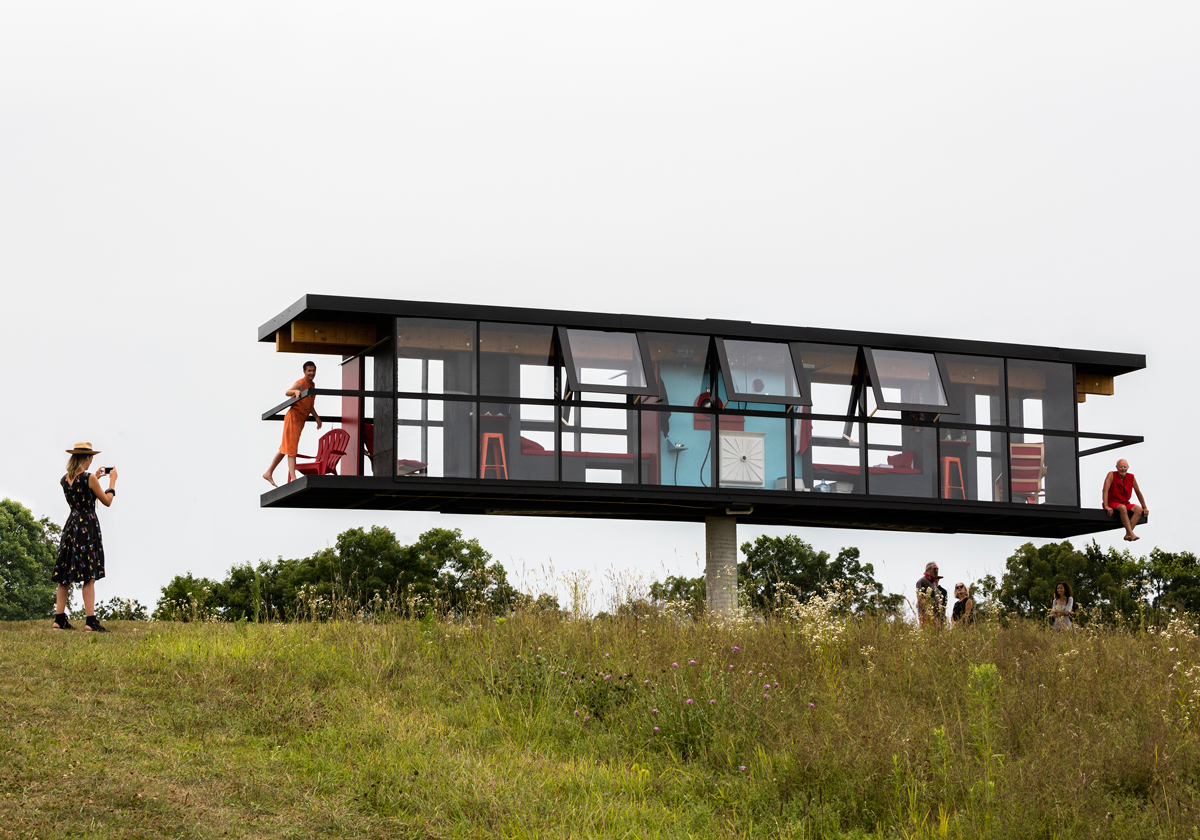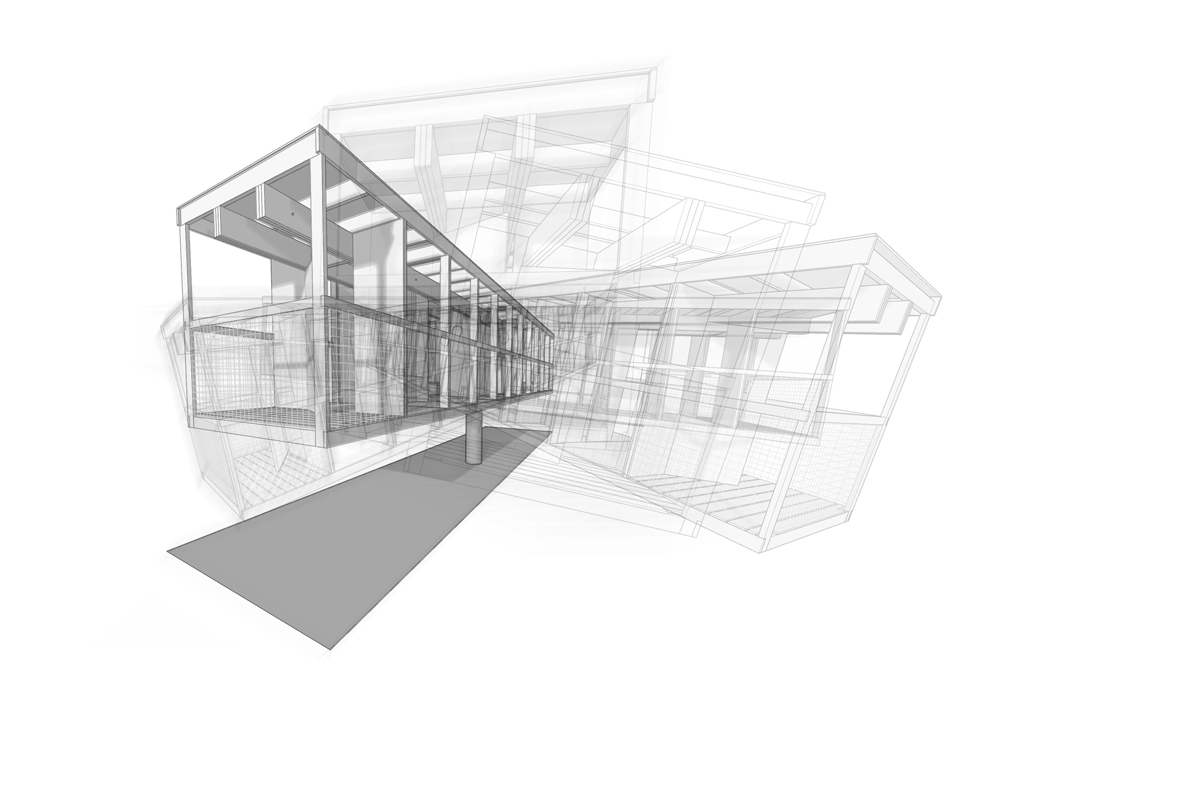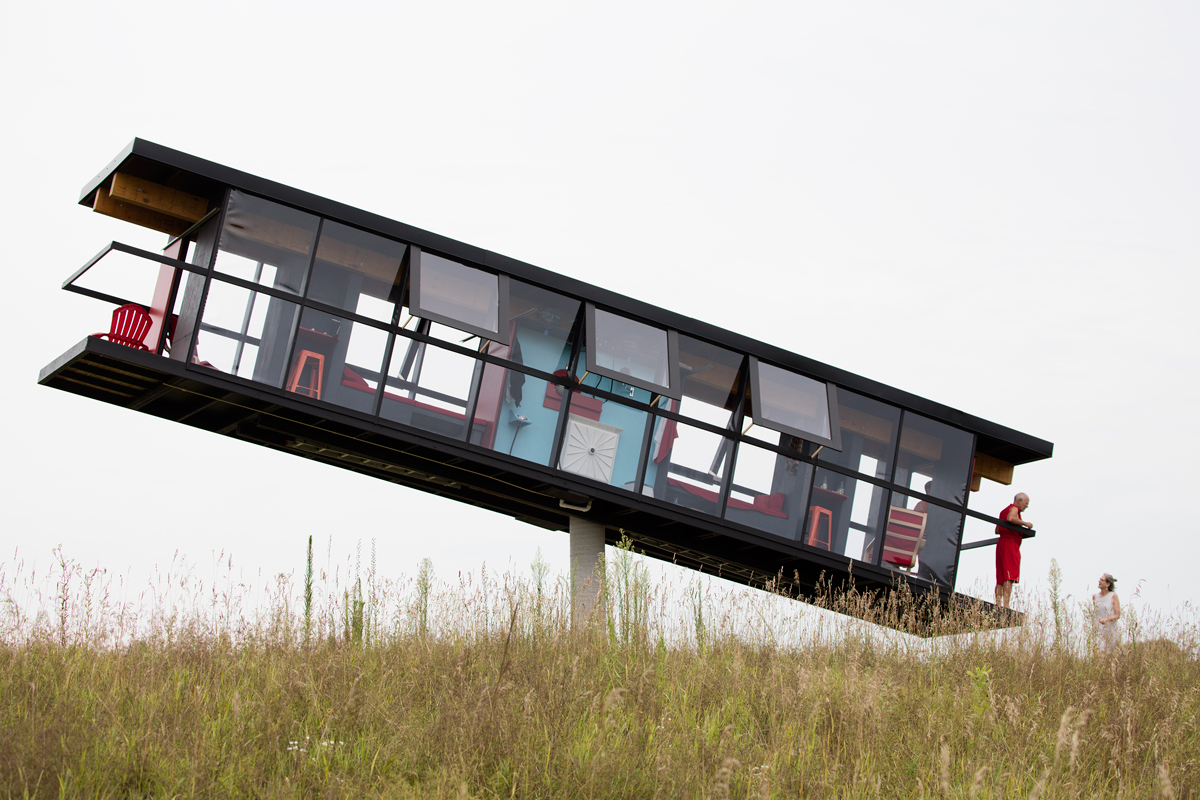WHEN IT COMES TO DESIGNING A HOUSE, THE ARTISTS ROCK. A SPINNING HOUSE BY WARD SHELLEY AND ALEX SCHWEDER
It’s now been almost one hundred years since Le Corbusier’s legendary saying, “a house is a machine for living in,” shook the idea of what a house and living space were to the very core in the early 20th Century. Nowadays, in a time where technology and information find their way into almost every aspect of our daily lives and the development of the Internet of Things (IoT) has turned the physical world and information world into one interconnected network, the idea of smart homes or even smart cities are conceived from the interactions people have amongst each other as well as with information and physical spaces surrounding them. If one were to change Le Corbusier’s sentence into something a bit more contemporary, it would therefore probably sound something like, “a house is an intelligent machine for living in.”

Late July of 2016 was the time when Omi International Arts Center organized a very interesting and experimental exhibition where art and architecture overlapped. Named ‘ReActor’ the work was a collaboration between artist Ward Shelley and architect Alex Schweder who specifically defined the piece as a “social relationship architecture.” With interactions between humans, and humans and architectural structures and the environment as the key, the work proposed an idea which is somewhat different from the technologically derived interactions mentioned earlier.
It seems like ReActor returns to an interest in ‘inhabitants’ movements,’ an issue that has long been one of the most original essences of architecture, which refers to the living of two inhabitants within the same space. The work straightforwardly emphasizes the architecture’s structure using simple techniques and mechanisms without the need for complicated technology to tangibly present the interactions.

The structure possesses the physical appearance of a glass box with a wooden interior. Its 13.5-meter width and 2.5-meter height structure is placed entirely on a 4.6-meter high concrete column that functions as the house’s point of rotation. It distinctively divides the living space into two wings with a restroom located at the center. The slight movement of an inhabitant will immediately cause the house to rotate. As a result, the moves the two artists make intensify motions of the house whose rotation already responds to the presence of natural wind. Such connection accentuates the relationships between the inhabitants, the built structure and the living space, which is the key message that both Shelley and Schweder want their audience to realize. “We all have to find ways to adjust in order to reach the balance,” said Shelley.
The work is a part of Omi’s architectural exhibition called WOOD: From Structure to Enclosure that showcases all the interactions taking place throughout its five-day period. If anyone who has the chance to see ReActor in person cannot help but compare the work to the idea of living in an age where “a house is an intelligent machine for living in,” we’ll totally understand.

หลังจากที่ประโยคอย่าง “A house is a machine for living in” ของ Le Corbusier ได้สั่นสะเทือนไอเดียเกี่ยวกับบ้านและที่อยู่อาศัยในต้นศตวรรษที่ 20 มาแล้ว ผ่านมาเกือบหนึ่งร้อยปี ในศตวรรษที่ 21 ในยุคสมัยที่เทคโนโลยีและข้อมูลข่าวสารต่างๆได้แทรกซึมเป็นส่วนหนึ่งของชีวิตประจำาวัน และการพัฒนาเทคโนโลยี Internet of Things (IoT) ทำาให้โลกทางกายภาพและโลกของข้อมูลโยงใยกันเป็นเครือข่าย ไอเดียเรื่อง smart homes ไปจนถึง smart cities ล้วนเกิดจากการมีปฏิสัมพันธ์กันระหว่าง ผู้คน ข้อมูล และพื้นที่ทางกายภาพต่างๆ แทบทั้งสิ้น ดังนั้นหากจะเปลี่ยนประโยคของ Le Corbusier ให้เข้ากับโลก ยุคปัจจุบันแล้ว เราอาจต้องเปลี่ยนคำาพูดเสียใหม่เป็น “A house is an intelligent machine for living in”
ช่วงปลายเดือนกรกฎาคม 2016 Omi International Arts Center ได้จัดแสดงงานทดลองที่อาจเรียกได้ว่าดูก้ำากึ่งกันระหว่างความเป็นสถาปัตยกรรมและศิลปะ นั่นคือ ReActor ผลงานที่เป็นการทำางานร่วมกันของศิลปิน Ward Shelley และสถาปนิก Alex Schweder ทั้งสองเรียกผลงานชิ้นนี้ว่า “social relationship architecture” ที่มีการปฏิสัมพันธ์กันระหว่าง มนุษย์ โครงสร้างทางสถาปัตยกรรม และสภาพแวดล้อม เป็นหัวใจหลักของงาน และมีไอเดียต่างไปจากการมีปฏิสัมพันธ์ผ่านเทคโนโลยีสมัยใหม่ที่ได้พูดถึงไปในตอนต้น
ดูเหมือนว่างาน ReActor จะกลับไปให้ความสนใจประเด็นที่เป็นแก่นแกนดั้งเดิมของงานสถาปัตยกรรม นั่นคือให้ความสนใจในเรื่องการครองและเคลื่อนไหวในพื้นที่ของผู้อยู่ (inhabitants’ movements) ที่สัมพันธ์กับการอยู่ของผู้อยู่อาศัยทั้งสองคนในพื้นที่เดียวกัน รวมทั้งยังเน้นไปที่ตัวโครงสร้างของสถาปัตยกรรมอย่างตรงไปตรงมา โดยไม่ต้องผ่านเทคโนโลยีที่สลับซับซ้อน แต่ใช้เทคนิคและกลไกธรรมดาเสริมให้เราได้เห็นปฏิสัมพันธ์นี้อย่างเป็นรูปธรรม
ด้วยโครงสร้างที่มีลักษณะเป็นกล่องกระจกและภายในเป็นไม้กว้าง 13.5 เมตร และ สูง 2.5 เมตร โดยทั้งหมดวางอยู่บนเสาคอนกรีตสูง 4.6 เมตร เพียงต้นเดียวที่ทำหน้าที่เป็นจุดหมุนของบ้าน บ้านทั้งหลังจึงถูกแบ่งออกเป็นพื้นที่อยู่อาศัยสองฝั่งอย่างชัดเจน คั่นด้วยห้องน้ำตรงกลาง ซึ่งการเคลื่อนไหวของแต่ละคนเพียงนิดเดียวจะมีผลต่อการเอียงของบ้านทันที ทำให้บ้านที่หมุนอยู่บนแกนเสาตามแรงลมจนแสงแดดเปลี่ยนตำแหน่งภายในบ้านอยู่ตลอดอยู่แล้วก็จะมีท่าทีที่เปลี่ยนไปทุกๆ จังหวะที่ศิลปินทั้งสองเคลื่อนที่ ทำให้ความสัมพันธ์ของคนกับโครงสร้างและพื้นที่อยู่อาศัยถูกขับออกมาให้เห็นทางกายภาพอย่างชัดเจนซึ่งก็คือ “message” หลักที่ทางศิลปินทั้งคู่ต้องการจะสื่อสารให้ผู้ชมได้ตระหนักถึง เพราะ “เราต้องอาศัยการปรับตัวอยู่ตลอดเพื่อหาความสมดุล” Shelley กล่าว
ผลงานชิ้นนี้เป็นส่วนหนึ่งของนิทรรศการทางด้านสถาปัตยกรรมของ Omi ที่มีชื่อว่า WOOD: From Structure to Enclosure ซึ่งจัดแสดงให้คนเห็นปฏิสัมพันธ์ที่เกิดขึ้นภายในเป็นเวลา 5 วัน ซึ่งถ้าใครไปดูงานนี้แล้วจะมีประเด็นเปรียบเทียบกับการอยู่ในยุค “A house is an intelligent machine for living in” ขึ้นมาก็คงไม่มีใครว่าอะไร
TEXT: WICHIT HORYINGSAWAD
PHOTO COURTESY OF ART OMI / ©RICHARD BARNES
omiartscenter.org
alexschweder.com
wardshelley.com

